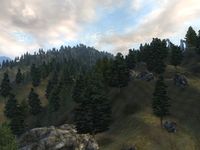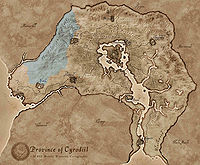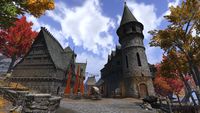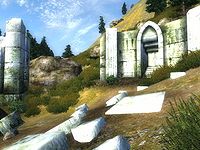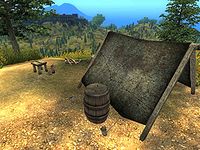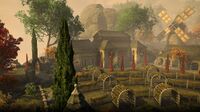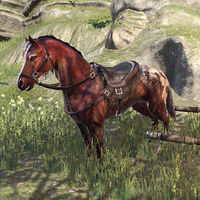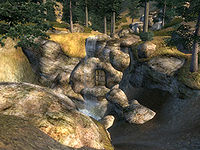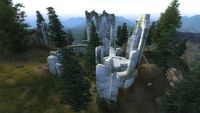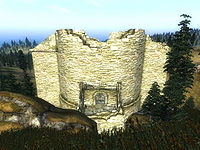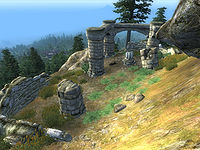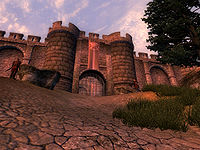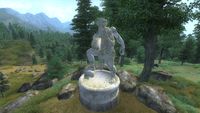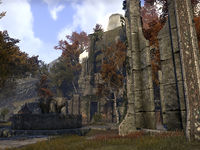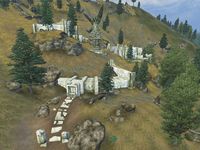User:Vincentius1/Sandbox 3
Introduction[edit]
| Colovian Highlands | |
|---|---|
| Type | Region |
| Continent | Tamriel |
| Province | Cyrodiil |
| Subregions | Battlehorn Imperial Reserve Strid Vale |
| Demonym(s) | Highlander[1] |
| Appears in | Oblivion, ESO |
Society and Geography[edit]
Demographics[edit]
Unlike other parts of Cyrodiil, like the Heartlands or even Colovia's county seats, the Colovian Highlands is remote, the furthest from civilization.[2] By the late Third Era, no one lived in the region,[3] but as late as the Interregnum, settlements have existed to some capacity.[4] The Highlands' main demographic is historically the Colovians, the western Imperials of Cyrodiil, but here, they distinguished themselves as Highlanders.[1] One of the region's main settlements were Ontus and Leftwheal,[5] and though it falls more in the Great Forest, County Chorrol and its capital city overlap with the region.[1][6]
In the Interregnum, most of Colovia, between Varen's Wall and central Cyrodiil were considered part of the West Weald, with Skingrad as its capital. Parts of the Gold Coast that did not fall into Varen's Wall (i.e., Sutch and Niryastare) ostensibly became part of the Colovian Highlands and marked the Highlands Road.[4][5] Some notable figures and families are from the Colovian Highlands include the Imperial scholar, Dubicius,[7] and House Valente, who were well-known winemakers.[8] Somewhere west of Skingrad, near the Weatherleah Estate was Villa Doria, the old estate of Emperor Brazollus Dor.[9]
Because the Highlands fall right on the border with Hammerfell, many Redguards settled here and provided a taste of Hammerfell's lifestyle. It was especially seen in Leftwheal as the overland route with Rihad still had active use.[5] As recent as the late Third Era, the Knights of the True Horn from Lainlyn briefly lived in the northernmost Highlands.[10] Many Ayleid ruins litter the region. Their histories are mostly unknown, except they were part of the Ayleid Empire. Some of their main settlements include Talwinque and Varondo, whose clans largely survived the Ayleid Diaspora and settled in Valenwood.[11] Other ruins include Hrotanda Vale, Lipsand Tarn, Nonungalo, and Trumbe, though their purposes are unclear.[12]
Culture and Industry[edit]
When it had active settlements, the Colovian Highlands maintained roads connecting it to other parts of Cyrodiil. The only major colored road that went through the region was the Black Road. This road mainly passes through the Great Forest and branches with the Orange Road in Chorrol, but it continues west, around the city's south wall into the northernmost Colovian Highlands,[13] then finally across the provincial border to Hammerfell where it links with the village of Stonedale, southwest of Elinhir.[14][15]
On the other hand, the Highlands Road was a major road that ran all through the region and somewhat adjacent to the Gold Road to the south. The two meet on a hill called Three Points, through a secondary route. It also ends in the east at a converging point between the Highlands and Great Forest called North Hook, and in the west around Sutch and Varen's Wall.[4]
- Extrapolate more[5]
Half of the central Colovian Highlands and the western Great Forest are known as the Imperial Reserve, a large tract of plains previously reserved for the Cyrodilic Emperors. It was Brazollus Dor, the fifth Emperor of the Reman Dynasty to claim this land as their hunting ground, but after the Akaviri Potentate period, local Colovians quietly resumed hunting there. Nowadays, it is more of a name on the map[16] and a long way from civilization.[17]
The Imperial Legion used to operate in many forts scattered across the Colovian Highlands, back under the Kingdom of Kvatch and the First Empire.[5][18] Up north, Fort Rayles was once part of the Transitus Network that connected it with other strongholds in central Cyrodiil.[19] In the south, Forts Hastrel, Linchal, and Ontus participated in Colovia's many incursions into Reaper's March.[18] Back then, the Legion drank special, alchemically brewed alcohol called Shadowbanish Wine, which gifted the soldier's night eye for long watches at night.[20] After Tiber Septim's rise to power, a great re-construction occurred across the province, but the many forts in the Highlands were never repaired.[21]
A Colovian Highland style of ale is strong and sweet, with just a taste of juniper. By the early Fourth Era, it was popular all over Colovia but it was seldom seen in Nibenay.[25]:Part 2, Chapter 7
Ecosystem[edit]
The Snow-Blanket Sorrel Horse is native to the Colovian Highlands, as well as a common sight between Chorrol and Bruma. It is known for its intelligence and high spirits.[26] The Highland Spotted Lynx is a species native to the region. They were previously uncommon, but an opportunistic hunter brought cubs with him and they have since become premium vermin killers in the area.[27][28] The brown Highland Wolf is a common creature found between here and the Great Forest. Local farmers and shepherds fear their wild packs, but some foresters have domesticated them and turned them into mounts.[29]
History[edit]
Early History[edit]
The earliest remnants of civilization in the region are the Ayleid ruins,[12] formerly city-states of the Ayleid Empire. The Ayleids lived in Cyrodiil as early as the Middle Merethic Era,[31] though much of their history is unknown. One known event at the time was the Harrowing of Varondo, when the Ash Titan, Arox the Mutilator scorched an Ayleid army "like dry grass in a wildfire". The city survived as far as the third century of the First Era, but like many other cities, it was abandoned after the Fall of White-Gold Tower in 1E 243. However, clans from Varondo and neighboring Talwinque escaped into Valenwood to find safety with the Bosmer.[11]
For the newly freed Nedes and the Cyro-Nords, ancestors of the modern-day Colovians, the west was viewed as the wild frontier, and they are yearning to conquer it.[21] In the early days of Cyrodiil, with the Alessian Order ruling over the Imperial City, Colovia was ruled by petty kingdoms, such as Kvatch and Skingrad that formed the original Colovian Estates.[32][33][34] Centered in their eponymous cities, portions of the Colovian Highlands swore fealty to these kingdoms. The Legion Cohorts in Forts Hastrel, Linchal, and Ontus, led by General Thibaut of Kvatch marched into Reaper's March during one of the kingdoms' many incursions south.[18]
The Colovian Estates, over the years, resisted the Alessian Order's advances and enforcement of their doctrines. Most famously was when Prince Rislav Larich usurped Skingrad's throne from his brother, the Marukhati priest, Dorald Larich. The ensuing war between the Estates and the First Empire under Emperor Gorieus. After an ambush on the Gold Road, the Alessian Army fled north into the Colovian Highlands, where they met King Justinius of Kvatch. Within an hour, north of the Imperial Reserve, the Emperor and his warriors fled east into Nibenay and lost the conflict. This war marked the beginning of the Alessian Hegemony's end, and it earned Rislav the epithet of "the Righteous".[33]
The Highlands in the Second Era[edit]
The Third Era and Onward[edit]
Notable Locations[edit]
- Battlehorn Castle
- A modern stronghold and former base of the Knights of the True Horn
- Cloud Top
- A mountain summit near the provincial border
- Fort Hastrel
- A ruined Imperial watchtower from the First Empire
- Fort Linchal
- A former Imperial outpost and historical settlement near Kvatch
- Highlands Road
- The main road between Sutch on the Gold Coast and the Imperial Reserve
- Leftwheal
- A large trading town on the Brena River's headwaters
- Lipsand Tarn
- An Ayleid ruin that people avoid out of superstition near Chorrol
- Nonungalo
- An Ayleid ruin filled with interred dead
- Ontus
- A historical Colovian settlement with a mixed Imperial and Redguard population
- Talwinque
- A large Ayleid ruin known colloquially as the Eaglerock Ruins
Gallery[edit]
Notes[edit]
See Also[edit]
- For game-specific information, see the Oblivion and Elder Scrolls Online
 articles.
articles.
References[edit]
- ^ a b c Gureryne Selvilo's dialogue in Oblivion
- ^ Pocket Guide to the Empire, 3rd Edition: The Seat of Sundered Kings: Cyrodiil — Imperial Geographical Society, 3E 432
- ^ a b Wilderness rumors in Oblivion
- ^ a b c West Weald in ESO: Gold Road
- ^ a b c d e f Traveler's Guide to West Weald — Beragon, Imperial Scribe
- ^ Countess Arriana Valga's dialogue in Oblivion
- ^ Castles and Coffers Volume III: Hel Ra Citadel
- ^ a b Wines of West Weald — Orius Hertano
- ^ a b The Emperor of the Villa — Valenca Arvina, Historian-in-Residence at Gwylim University
- ^ Lord Kelvyn's Will — Lord Kelvyn
- ^ a b Ayleid Survivals in Valenwood — Cuinur of Cloudrest, 4th Tier Scholar of Tamrielic Minutiae
- ^ a b c Colovian Highlands in Oblivion
- ^ Map of Cyrodiil – The Elder Scrolls IV: Oblivion
- ^ Map of the Imperial Province – The Elder Scrolls: Arena
- ^ Map of Hammerfell – The Elder Scrolls: Arena
- ^ a b c A Hunter's Journey II: The Imperial Reserve — Viola Fulcinius, Professional Hunter
- ^ Fadus Calidius' dialogue in Oblivion
- ^ a b c Thibaut's Cairn and its History — Charonius of Sutch
- ^ a b Cyrodiil in ESO
- ^ Nerussa's dialogue in Oblivion
- ^ a b Pocket Guide to the Empire, 1st Edition: Cyrodiil — Imperial Geographical Society, 2E 864
- ^ Cite error: Invalid
<ref>tag; no text was provided for refs namedOBArriana - ^ Baroness Eliana Cossa's dialogue in ESO: Gold Road
- ^ Wines of Blackwood — Orius Hertano
- ^ The Infernal City — Greg Keyes
- ^ Snow-Blanket Sorrel Horse mount description in ESO
- ^ Highland Spotted Lynx Bundle description in ESO
- ^ Highland Spotted Lynx mount description in ESO
- ^ Highland Wolf mount description in ESO
- ^ Linchal Titian Fox pet description in ESO
- ^ Before the Ages of Man — Aicantar of Shimerene
- ^ The Lost Fort Faleria
- ^ a b Rislav The Righteous — Sinjin
- ^ An Abbreviated History of Skingrad — Antonious Civello, University of Gwylim Press
- ^ Legion's Rest loading screen text in ESO: Gold Road
- ^ Varen's Wall — Midara Salviticus, Historian, University of Gwylim
- ^ Meet the Character - Tribune Alea — Commander Merian
- ^ The Great War
